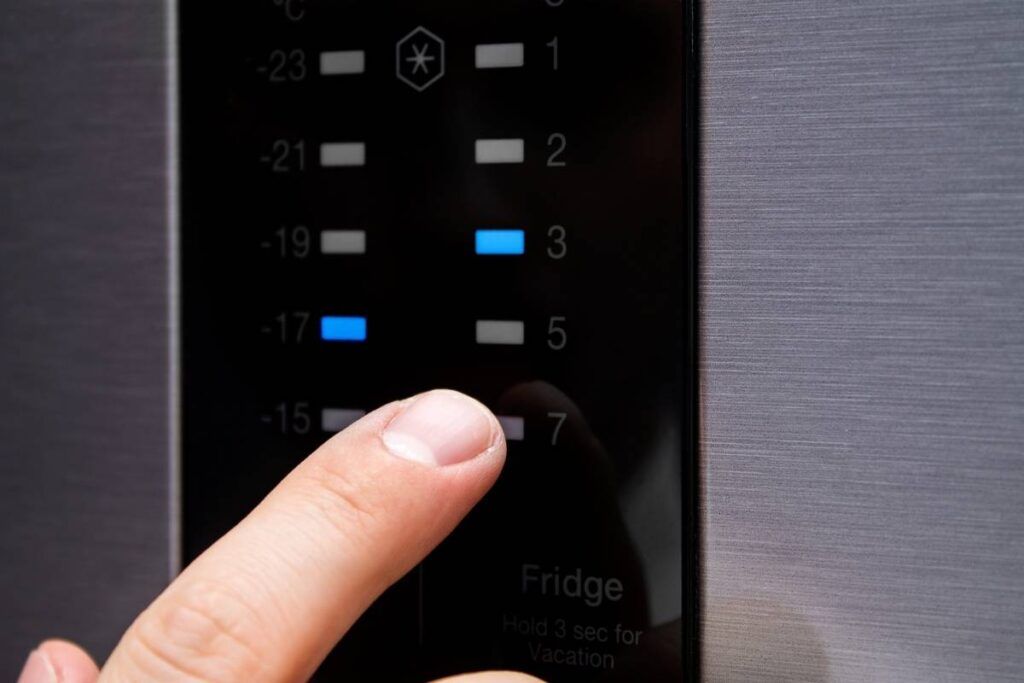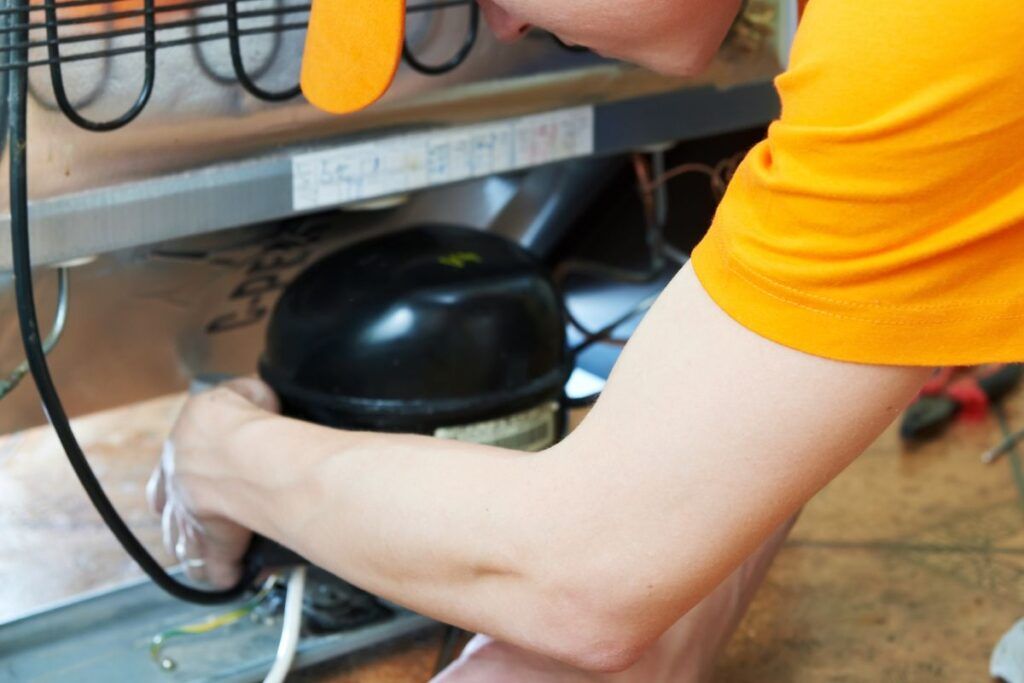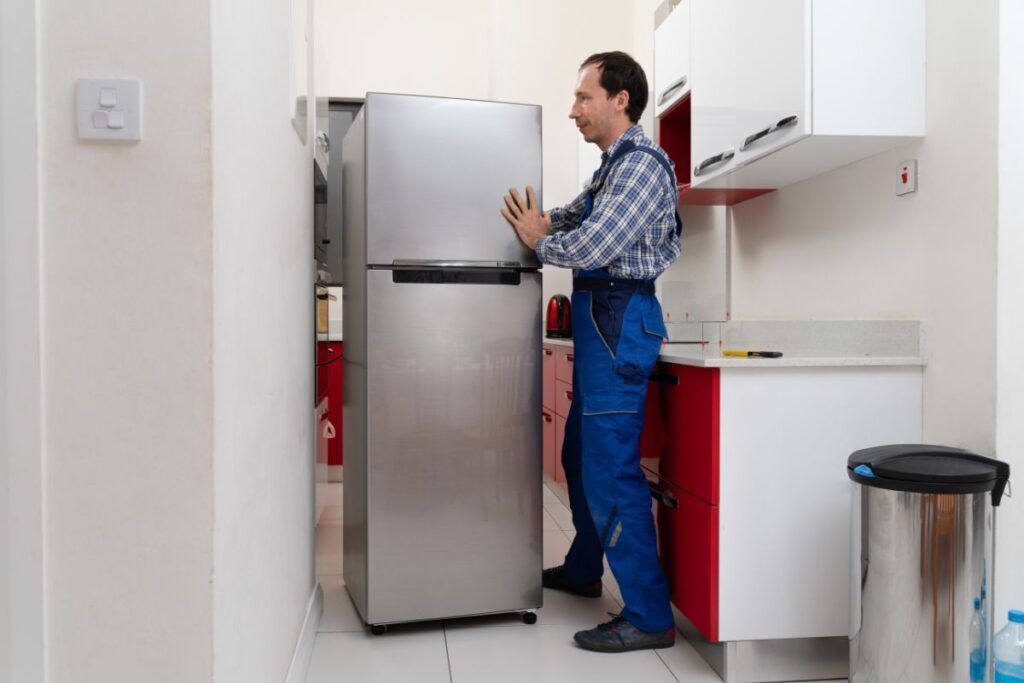Are you frustrated with the fluctuation of temperature in the refrigerator? Does it stay too cool or too hot at times? If that’s the issue in your refrigerator, you are at the right place.
When you notice temperature fluctuation in your refrigerator, check the condenser coil, evaporator fan, and door seal. If they are dirty or worn out, replace them to fix the issue. Overloading the refrigerator will also cause temperature fluctuations due to the blocked airflow.
In this guide, you will learn about 10 common causes and how to fix the issues. So, keep reading.

Check out our list of top-handpicked products for all your electrical, appliance, and HVAC system needs to keep your home running smoothly.
This post includes some affiliate links.Why does my refrigerator temperature keep changing?
A refrigerator is a huge investment every one of us makes.
Still, the money we spend on it is worth it.
A refrigerator helps to inhibit the growth of microorganisms from preserving food, and also it helps to serve the chilled drink.
If the refrigerator temperature goes up and down, it would be difficult to maintain the standard temperature.
As a result, the food content inside the refrigerator will spoil.
I had a similar experience with my refrigerator.
Initially, I noticed that the temperature of the refrigerator was not stable.
I thought it was normal, but it caused issues in the refrigerator.
It caused the food inside my refrigerator to spoil.
I then initiated the research and fixed the issue in my refrigerator by replacing the thermostat.
Here are the 10 common issues of temperature fluctuations in the refrigerator.
Let’s see them one by one.
1. Overloading

People often stuff groceries and vegetables inside the refrigerator to avoid going to the market frequently.
I used to do this but stopped overloading when I knew its consequences.
It would be best if you also stopped overloading your refrigerator to get rid of issues.
Let’s discuss the consequences of overloading the refrigerator, which results in temperature fluctuations:
- Blocked vent in the freezer.
- Food content spoils.
- Reduced energy efficiency.
Due to stuffing the content inside the refrigerator, the airflow inside it will get blocked.
As a result, the motor will work hard to maintain the temperature.
In the long run, the motor will fail, and you must replace it entirely.
A small mistake of overloading the temperature will cause a huge repair cost.
The lack of airflow inside the refrigerator will cause a favorable environment for bacterial growth.
The bacterial growth in the refrigerator will spoil the food quickly.
Sometimes, consuming food stored at a warm temperature will cause health hazards.
Also, overloading the refrigerator causes wear and tear, resulting in higher energy consumption.
Understand the capacity of your refrigerator and load it accordingly.
It will prevent the consequences.
2. Faulty Thermostat
The thermostat is essential to keeping the refrigerator’s temperature in control.
It turns on and off the refrigerator to maintain the pre-set temperature.
If the thermostat is faulty, you must replace it to fix the issue.
When the thermostat is filled with dust and debris, it will fail to maintain the standard temperature inside the refrigerator.
Suppose that’s the case in your refrigerator. Locate the thermostat and clean it using a soft cloth.
Also, check the wires attached to the thermostat.
Sometimes the faults in wires or loose connections.
It will also cause the issue.
Even after cleaning the thermostat, if the issue persists, seek help from professionals to replace the thermostat.
Replacing the thermostat involves opening the protective panel outside the thermostat.
You can know the exact location of the thermostat by referring to the user manual of your refrigerator.
Remove the thermostat and disconnect the thermostat wires from the refrigerator using a screwdriver.
Replace it with the new thermostat and secure it with screws.
Reattach the panel and secure it with screws.
If you are uncomfortable doing this, you can seek professional help to replace it.
3. Dirty Condenser Coils

Condenser coils are located at the back of the refrigerator.
The primary function of the condenser coil is to remove the heated air from the vapor gas and turn it into a saturated liquid.
It is called the process of condensation.
If the condensation coil is dirty, the airflow in the condenser coil will be blocked.
They must be clean to be able to do the job efficiently.
If the condenser coil is dirty, the heated air will circulate back to the refrigerator, causing the issue.
When circulated into the fridge, the heated air causes temperature fluctuations.
You can fix this issue by cleaning the condenser coil.
First, check if the condenser coil is dirty.
If that’s the case, clean the condenser coils of your refrigerator.
To clean the condenser coil, unplug your refrigerator from the electric outlet.
Move the refrigerator away from the wall.
Use a soft-bristled brush to clean the dust.
Use a vacuum to clean the condenser coil’s remaining dust and debris particles.
Replug the refrigerator and move the refrigerator to its original position.
Check if the issue is solved.
4. Door Seals
The door seal is located at the frame of the door. It helps to prevent leakage of air from the refrigerator.
Due to the frequent opening and closing of a door, the door seal may be worn out.
In such a case, the air will start escaping from the refrigerator.
It will cause fluctuation in the temperature inside the refrigerator.
If the door seal is worn out in your refrigerator, replace the door seal.
You can see the obvious signs in the door seal. The signs of worn-out door seals are bubbled and wrapped.
You can buy the replacement part from the online website.

5. Air Vents Blocked
Check if you are blocking the air vent of the refrigerator with the food containers.
The air vent escapes warm air from the refrigerator to maintain the desired temperature.
If the food containers block the air vents inside the refrigerator, the temperature will become warm.
In such a case, the refrigerator’s food contents will get spoilt.
You must take out the contents blocking the air vents inside the refrigerator.
Ensure proper ventilation for smooth airflow inside the refrigerator.
6. Power Outages
If there are continuous power outages, the temperature inside the refrigerator will become warm.
Whenever the power is restored, a refrigerator will work hard to retain the temperature inside it.
A power outage will cause temperature fluctuations.
You can control the power fluctuations during power outages by monitoring the temperature using a thermometer.
If the refrigerator temperature reaches 40 degrees Fahrenheit, unload all the perishable food content.
When a power outage occurs, avoid opening the refrigerator door frequently.
Opening the door frequently will cause the temperature inside the refrigerator to rise quickly.
It is always best to purchase a generator to avoid temperature fluctuations due to power outages.
Power outages will also cause internal damage to the refrigerator.
7. Defective Parts

Temperature fluctuations also occur due to faults in the internal parts.
If you have checked all the issues mentioned above and still the temperature fluctuations occur, you must check the internal parts of the refrigerator.
- Compressor.
- Evaporator fan.
- Condenser fan.
Faults in these parts will also cause temperature fluctuation in the refrigerator.
Let’s understand each interior part’s function and what faults cause the power fluctuations.
The primary function of the compressor is to circulate the refrigerant throughout the refrigerator system.
It also raises the pressure in the refrigerant to make it hot.
Refrigerant is the essential component to maintain the cool temperature in the refrigerator.
If the refrigerant is not circulated due to the faulty compressor, the refrigerant will not be circulated in the refrigerator.
It will result in a warmer temperature in the refrigerator.
In such a case, you must replace the compressor.
To replace the refrigerator’s compressor, you can seek help from professionals.
The second one is the evaporator fan at the back of the refrigerator.
The primary function of the evaporator coils is to circulate air to the coil of the evaporator and to remove heat from it.
If the evaporator coil is faulty, air circulation will be blocked, and warm air will enter the refrigerator.
It will cause temperature fluctuation in the refrigerator.
You can fix the issue by replacing the evaporator fan.
You can locate the condenser fan at the bottom of the refrigerator.
The condenser coil takes air from the front and rear sides of the refrigerator.
And it circulates the air through the front grille and takes it to the compressor.
From the compressor, air will be released into the room.
Doing this, an evaporator coil maintains the cool temperature inside the refrigerator.
Airflow won’t be in any of these inner parts if the evaporator fan is damaged or faulty.
And it will result in power fluctuations.
In such a case, replacing the evaporator fan will fix the issue.
You can seek help from a professional to inspect if any of these parts malfunctioned in your refrigerator.
If these are faulty, replacing them will fix the issue.
8. Location of the Fridge

Another critical factor in the temperature fluctuation in the refrigerator is the location in which it is placed.
Check if your refrigerator is,
- Placed in the warmer room.
- Placed near the heat source.
- If there is no airflow.
- Placed on the unlevel surface.
- Placed near the appliances like dishwasher and oven.
The temperature of the room where it is placed affects the refrigerator’s efficiency.
If placed in a warmer room, the refrigerator’s compressor will work hard to maintain a cool temperature.
Due to the compressor’s excessive workload, temperature fluctuation will occur.
So, it is crucial to maintain the room’s temperature between 60 – 80 degrees Fahrenheit.
Also, if the refrigerator is placed too close to the dishwasher or oven, it will cause temperature fluctuation due to a hike in the temperature in the surrounding area.
Check if your refrigerator is placed in an enclosed area with less airflow.
Placing a refrigerator in such an environment will cause the compressor to work hard to maintain the desired temperature.
Due to this, temperature fluctuations occur.
Check if your refrigerator is placed on a leveled surface.
Placing the refrigerator on an unlevel surface will cause temperature fluctuations.
You can avoid this by placing the refrigerator on a flat surface.
You can also check if your refrigerator is on a leveled surface by measuring it with a leveled scale.
9. Dirty or Damaged Evaporator
An evaporator is a vital part located inside the refrigerator.
An evaporator absorbs the heated air from the refrigerator’s interior to expel it to the outside environment.
When the evaporator is damaged or broken, it will fail to transfer heat from the refrigerator’s interior to the exterior leading to temperature fluctuations.
In such a case, a refrigerator will struggle to maintain the desired temperature.
A damaged evaporator will also cause uneven cooling in the refrigerator.
In such a case, you must replace the evaporator inside the refrigerator.
10. Refrigerant Leaks

Refrigerant helps maintain the cold temperature in the refrigerator.
It helps by transferring the heated air from the inside of the refrigerator to the outside.
It does this by traveling through the evaporator and condenser coil.
If the refrigerant leaks throughout the cycle, it will reduce the cooling efficiency of the refrigerator.
Faults in the condenser and evaporator coil will also cause refrigerant leakage.
If refrigerant leaks in your refrigerator, you must seek professional help to fix the issue.
Final thoughts
A temperature fluctuation may occur due to several faults in the refrigerator. You must understand the causes to fix the issues effectively. The common causes include the overloading of a refrigerator, faulty thermostat, dirty condenser coil, door seal, or blocked air vents.
Inspect all the causes and try the fixes mentioned in the article. If the temperature fluctuation continues in your refrigerator, you must seek professional help.
Maintaining a regular cleaning schedule to keep the condenser coil and evaporator fan clean will help to avoid temperature fluctuation due to the blocked airflow.
Should a fridge keep a constant temperature?
Yes, it is vital to maintain a constant temperature to keep the food inside fresh.
How long should a fridge last?
The refrigerator lasts between 10 and 20 years. However, maintaining the proper cleaning and service schedule will avoid faults in the refrigerator.
Reference: Refrigerator Wikipedia

